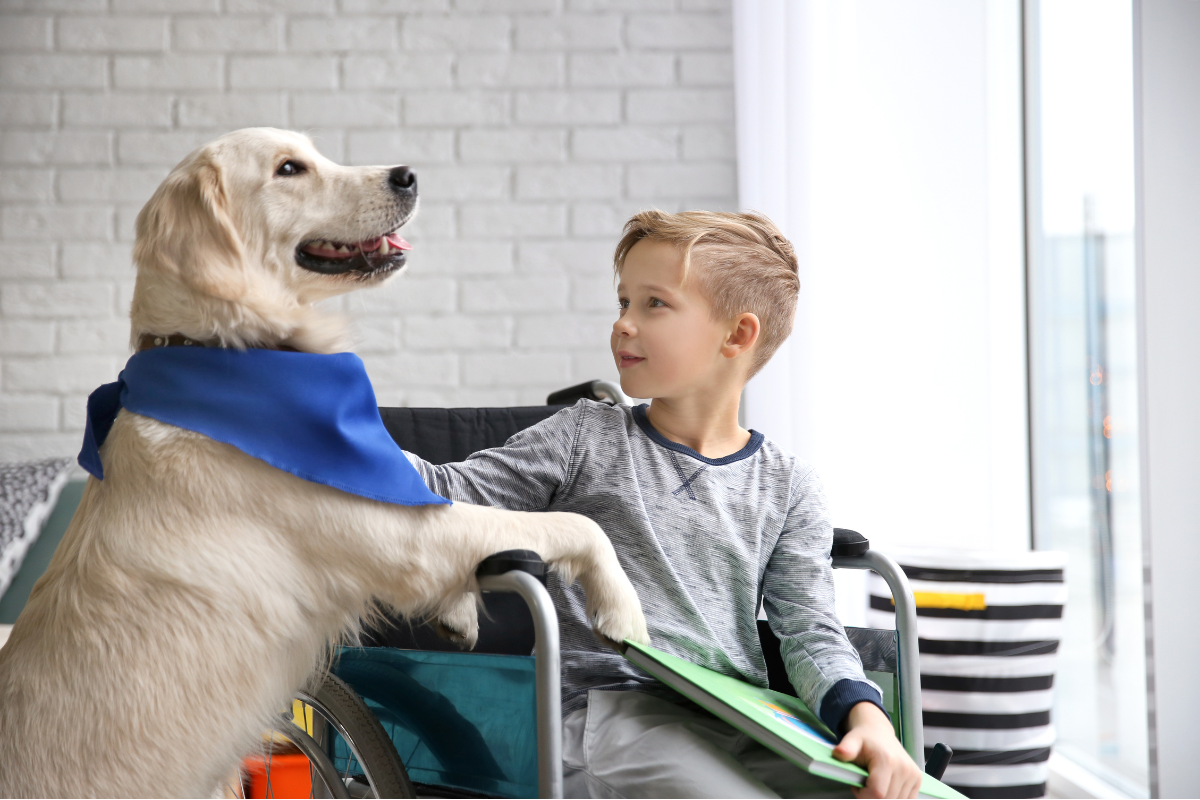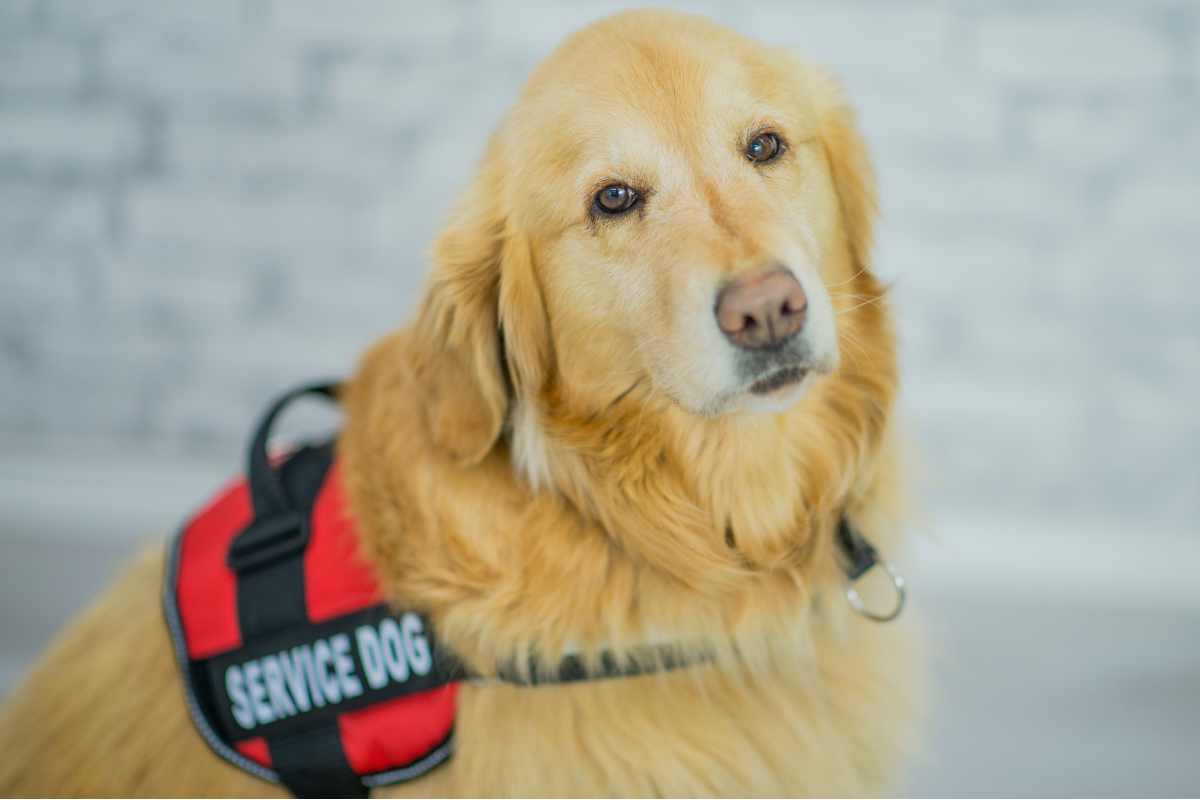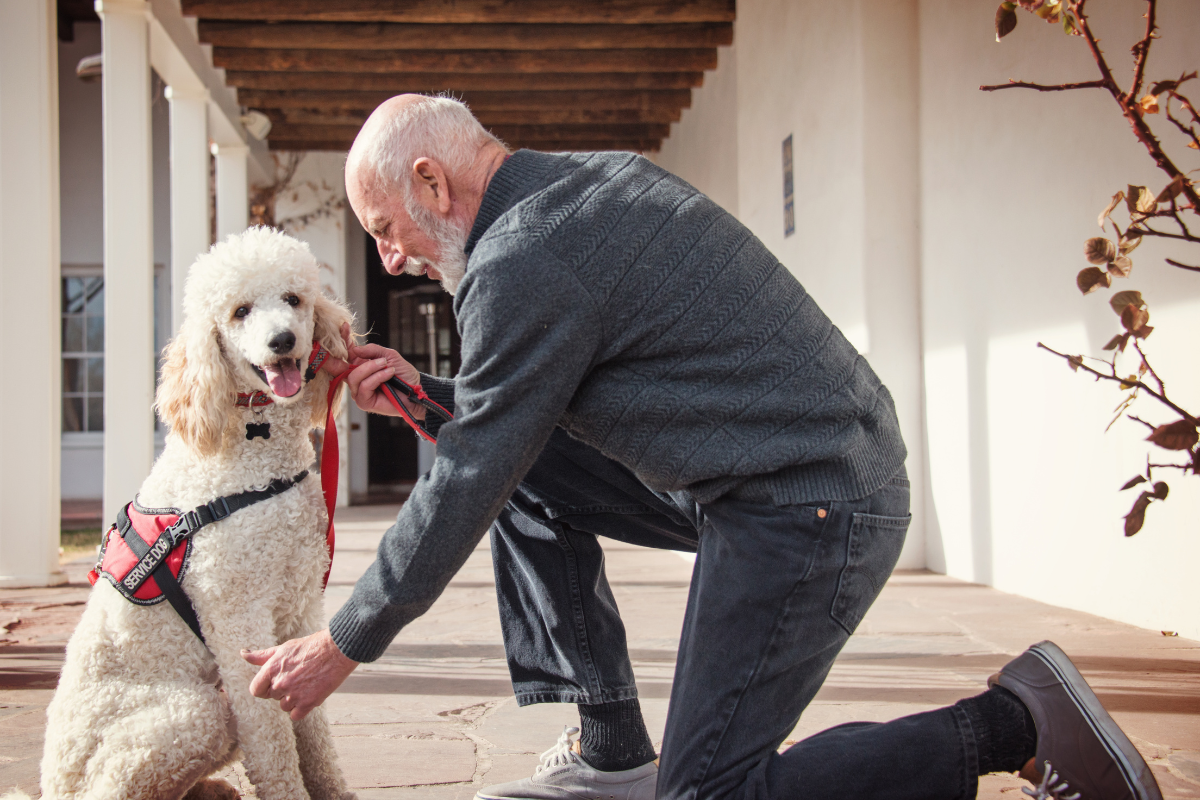Service dogs. This toolkit is meant to provide those considering getting a service dog in Alberta with the information they need in order to make an informed choice.
Types of Service Dogs
When we talk about service dogs, it is essential to recognize that there are different types of support dogs, and not all have the same rights to access. There are four types: service dogs, emotional support animals, therapy animals and accredited facility dogs.
Service Dogs
A service dog is one that is specifically trained to help someone with a disability. There are expectations of the dog, so that it can maintain public access. It must not bark, be aggressive, snap, bite, or damage property (Source).
It is specially trained and certified to perform tasks for an individual with visible and invisible disabilities like epilepsy, PTSD, vision impairment, diabetes, or mobility limitations.
- Dogs are specifically bred for this type of work, and receive vigorous training and frequent assessments for over 2 years.
- Have public access privileges and are allowed to go wherever their handler goes.
Emotional Support Animal
An emotional support animal provides comfort and emotional support to an individual with mental health needs. To qualify for an ESA, the owner needs to receive assessment and support from a qualified mental health professional or doctor.
- Training is not required for these animals
- Do not have public access privileges but often have housing and travel protections
While service dogs are protected by law in Alberta, allowing them rights to public access, emotional support dogs are not afforded the same rights. An emotional support dog is meant to offer their owner companionship and support without special training. They have limited access. Under the Service Dogs Act, emotional support dogs are not considered service dogs and do not have the same rights to access; meaning your dog can be denied entry to a public area.
Therapy Animal
A therapy dog is trained to work in specific locations such as a hospice, hospitals, schools, etc. They do not have the right to public access and are also not trained to support a specific disability. (Source)
It provides comfort and animal-assisted therapy support to many people in a variety of settings such as hospitals, nursing homes, schools, therapeutic settings, etc.
- Receives obedience training and is specially selected for their temperaments.
- Does not have public access privileges unless invited.
Accredited Facility Dog
A facility dog encourages participation and is there to reduce the anxiety of a client in a professional environment. They can be trained to offer deep pressure for clients experiencing anxiety. (Source)
- Specifically bred for this type of work and receive specialty training for over two years to ensure they have the right temperament, behaviour, health, and unique personality traits needed to perform their jobs.
- AFDs must pass International Accreditation Standards which allows them to work with their handler in areas such as schools, courtrooms, child advocacy centres, police stations, etc.
Pros & Cons of Getting a Service Dog
Are you thinking a service dog is right for you? Check out the following list of pros and cons parents and caregivers have listed about their experience with their service animal.
Pros
- Improved quality of life for individual and family
- Can reduce risk of individual running away
- Reduce strain on caregiver
- Provides feeling of safety and protection
- Creation of positive relationship
- Gives individual a sense of responsibility
- Gives caregivers an increased sense of ability to care for individual
- Increased social interaction when dog acts as facilitator
Cons
- Can be quite expensive, more than $10,000
- A lot of work in the beginning (like having another child)
- Potential of individual not connecting with the animal
- Extra expenses including food, toys, bed, training supplies, vet costs
- Could pose challenges when traveling
- Cleaning up after the animal
(Source)

Research
What benefits have caregivers noticed during research studies:
- Three-quarters of the participants saw improvement in their child’s communication.
- 50% noticed a reduction in problematic behaviours.
- All studies reported an increase in positive emotional experiences.

Think a service dog is right for you?
Now what?
You have options
- You can go with one of the several agencies approved by the Alberta government and get a fully-trained service dog.
- You can adopt a puppy and work with an agency to train your dog after the first six months
- You can adopt your own dog and self-train. There are also online options to support your training journey.
If you wish to go with a Government of Alberta-approved agency, follow this link to learn more.
What is the cost of getting a service dog through an agency?
Answer: It depends on many factors. Prices range from $5000-$20,000+
Are there programs to help with the cost of getting a service dog?
The short answer is no. However, there are several options for trying to get support to reduce costs:
- Look into your community’s organizations and see if they can help offset the cost
- Use local media to fundraise
- Start a Gofundme page
If you want to train your own service dog but would like some guidance, here are a couple of online options:
How long does it take to train a service dog?
- Intensive training, 2 years. You can begin when the puppy is six months old
- A slower approach is recommended for self-training, 3 years.
Service Dog Training Timeline

Planning
- Assess your needs
- Set up support system
- Get finances in place
- Health insurance for dog
- Identify training locations

Puppy
- Make sure the breeder you choose has done a good job with the dog
- Socialize the puppy

Adolescent
-
If you adopt an adolescent, you’ll need to make up for any social, emotional, cognitive, or behavioural issues
- Expose the dog to new locations
- Teach the dog to learn new concepts and that learning is fun

Adult
-
Ready to start work tasks
- Practice regularly
- Food rewards slowly fazed out
- Public access test

Maintenance
-
Refresher training periodically
- Refresh public access test annually (even if you don’t intend to go through certification process)

Extra Tasks
- May need to teach new tasks as your needs change

Retirement
-
When the dog starts slowing down
- When the dog loses interest in work
- If the dog’s health prevents work
- Begin training next service dog while the current dog is still actively working

If you would like to learn more about the process and benefits of getting a service dog, check out these resources:
- Article: How long does it take to train a service dog?
- Scholarly article: Research on animal-assisted intervention and autism spectrum disorder.
- YouTube Video: Timeline for Self-Training a Service Dog – Start to Finish



